The Story Behind the Photograph
How I photographed the Bushbabies and Genets
.jpg)
In last month's Tip of the Month (January-February 2012) I discussed a new infra-red remote camera firing system, the Range IR produced by Cognisys. One of the things I hoped to do with this small, easily transported unit was to try it out in Africa and India, where I happen to be right now, days from starting our Tiger Photo Safaris. In Tanzania, where we just completed a great safari, we were camping literally out in the bush, and there was no safe place to either put some bait to attract an animal and, two, where I wouldn't run the risk of a spotted hyena chewing up any or all of my equipment. In Kenya, however, one of our camps offered great subjects and was protected (?) by an electrified fence, so it was reasonably safe from hyenas.
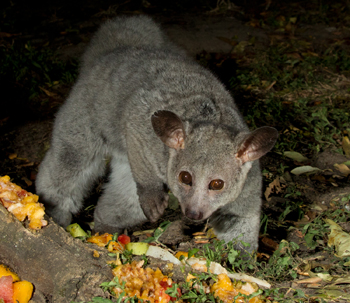
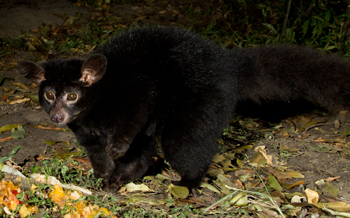
The bushbaby comes in two color morphs, a light gray and a black. At a previous camp I'd see only black bushbabies, but at our new camp the gray morph seems more abundant.
Using remotes are, in many ways, easier to use at night where an entire exposure can be made by electronic flash, and thus the exposure can be constant. During the day, when ambient light is likely to be involved, provisions must be made to either take this into account by either exposing for the ambient light, incorporating the ambient light with a flash photo, or underexposing the ambient light and doing the entire exposure by flash. All three can produce some problems.
If you expose for the ambient light, you must set your exposure mode on either shutter priority or aperture priority. Normally I use manual mode, but as the light would change throughout the day, not only in direction but also perhaps due to clouds, manual exposures would be too fixed. On either aperture or shutter priority that would not be an issue, but I could still run the risk of having too slow a shutter speed (if using aperture priority) or either too much light (with a slower shutter speed setting in shutter priority) or too little (with too fast a shutter speed in shutter priority, where a wider aperture than the minimum of a particular lens).
The same basic issues apply if attempting to balance, or incorporate in some way, ambient light and flash. And, if an exposure is made solely by flash, the background might go black, and look like a shot taken at night. Provisions can be made for this, but they take a bit of doing, and for my work in Africa it is a bit more than I have time to deal with.
Which leads to nocturnal photography, which is just great since I normally do not get a chance to photograph night active subjects. So, with a Range IR I can set up a simple flash system, go to bed, and check out the results the next morning when I retrieve my gear.
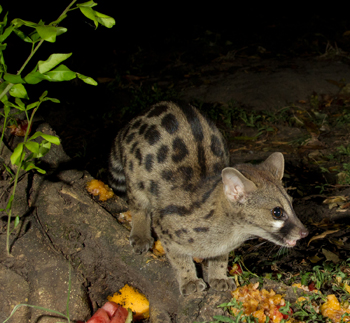
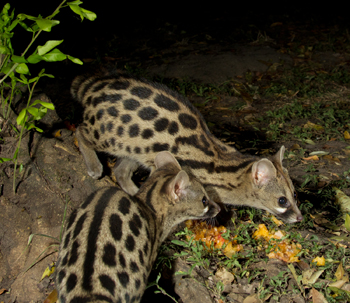
Spotted genets, also called genet cats, look a bit like a leopard or an Asiatic leopard cat, but they are not cats at all, but are more closely related to the mongooses. They are arboreal and nocturnal, agile and fast. Two came in to the bait site.
Unfortunately, I was more concerned with getting the shots than documenting how I set them up, as I had a very limited time between getting in from the afternoon game drive, going to dinner, and getting to bed. OK, that's an excuse, but it is a good one! Regardless, I can describe the setup.
The setup was fairly simple. I used a 28-300 lens to give me as much freedom in composition as possible, and mounted the camera/flash on a Gitzo tripod that I set fairly close to the ground, for near ground-level angles. Two flashes were used, set on Manual mode at a low power ratio so that, one, I'd stop any potential motion, and, two, so that my batteries would last as long as possible since the flash bursts themselves would not draw much energy..
I positioned my Range IR on the ground, set at an angle via a small rock so that the beam would cover the area directly above my bait site. I adjusted the beam so that the IR covered the distance and beyond. The flashes were positioned with one set a bit higher than the lens, and another, the 'slave' flash,
was set on a rock, mounted to my Gitzo monopod, with the front facing my 'master' flash. An infrared signal triggered the second flash, giving me even lighting.
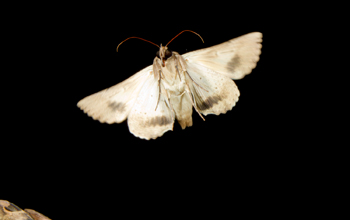 One evening, prior to setting up for the bushbaby and civet, I tried photographing the moths that hovered around our glasses of wine we shared before going to dinner. Stupidly, I forgot to bring the connector that would have triggered a flash unit directly from the Range IR, which would have enabled virtually instantaneous response time. Consequently, I had to wire the Range IR to the camera, and account for the lag time. Flashes were positioned close, to give me the fastest flash duration possible. I had minimal success, probably for two reasons. One, few moths visited my set, and two, moths would break the IR beam and be out of coverage before the camera fired. Nonetheless, I did get one shot, and I'll know to bring the right cable next time.
One evening, prior to setting up for the bushbaby and civet, I tried photographing the moths that hovered around our glasses of wine we shared before going to dinner. Stupidly, I forgot to bring the connector that would have triggered a flash unit directly from the Range IR, which would have enabled virtually instantaneous response time. Consequently, I had to wire the Range IR to the camera, and account for the lag time. Flashes were positioned close, to give me the fastest flash duration possible. I had minimal success, probably for two reasons. One, few moths visited my set, and two, moths would break the IR beam and be out of coverage before the camera fired. Nonetheless, I did get one shot, and I'll know to bring the right cable next time.
Using the Range IR on an exotic trip was successful, as I expected it to be. I'd have done a better job with another flash or two, and with a bit more forethought on how I was going to mount the flashes, and using a flash cable for the insects. Nonetheless, it worked, and if you're interested in expanding your coverage, and having a lot of fun capturing subjects you probably won't even see, this technique, and the Range IR, will be for you.
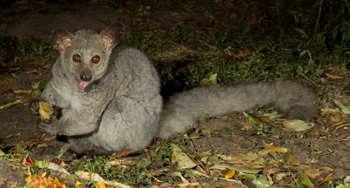
Past Stories Behind the Photograph
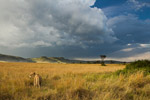

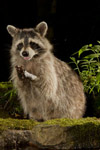
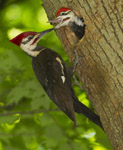


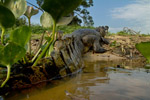
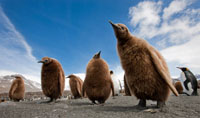

Barn Swallow
King Penguin
The Lion and the Landscape
The Bighorn Sheep
The Raccoon
The Pileated Woodpecker
The Striking Rattlesnake
The Pink Salmon
The Spectacled Caimen
Check out our latest web site,
mcdonaldwildlifephotos.com
where we'll be adding portfolios and eventually building up
a searchable data base for photo buyers. We've just started,
and the selection is limited, but it is still worth a visit!
Office Phone: (717) 543-6423
Or FAX us at: (717) 543-5342
The Story Behind the Photograph
How I photographed the Bushbabies and Genets
.jpg)
In last month's Tip of the Month (January-February 2012) I discussed a new infra-red remote camera firing system, the Range IR produced by Cognisys. One of the things I hoped to do with this small, easily transported unit was to try it out in Africa and India, where I happen to be right now, days from starting our Tiger Photo Safaris. In Tanzania, where we just completed a great safari, we were camping literally out in the bush, and there was no safe place to either put some bait to attract an animal and, two, where I wouldn't run the risk of a spotted hyena chewing up any or all of my equipment. In Kenya, however, one of our camps offered great subjects and was protected (?) by an electrified fence, so it was reasonably safe from hyenas.


The bushbaby comes in two color morphs, a light gray and a black. At a previous camp I'd see only black bushbabies, but at our new camp the gray morph seems more abundant.
Using remotes are, in many ways, easier to use at night where an entire exposure can be made by electronic flash, and thus the exposure can be constant. During the day, when ambient light is likely to be involved, provisions must be made to either take this into account by either exposing for the ambient light, incorporating the ambient light with a flash photo, or underexposing the ambient light and doing the entire exposure by flash. All three can produce some problems.
If you expose for the ambient light, you must set your exposure mode on either shutter priority or aperture priority. Normally I use manual mode, but as the light would change throughout the day, not only in direction but also perhaps due to clouds, manual exposures would be too fixed. On either aperture or shutter priority that would not be an issue, but I could still run the risk of having too slow a shutter speed (if using aperture priority) or either too much light (with a slower shutter speed setting in shutter priority) or too little (with too fast a shutter speed in shutter priority, where a wider aperture than the minimum of a particular lens).
The same basic issues apply if attempting to balance, or incorporate in some way, ambient light and flash. And, if an exposure is made solely by flash, the background might go black, and look like a shot taken at night. Provisions can be made for this, but they take a bit of doing, and for my work in Africa it is a bit more than I have time to deal with.
Which leads to nocturnal photography, which is just great since I normally do not get a chance to photograph night active subjects. So, with a Range IR I can set up a simple flash system, go to bed, and check out the results the next morning when I retrieve my gear.


Spotted genets, also called genet cats, look a bit like a leopard or an Asiatic leopard cat, but they are not cats at all, but are more closely related to the mongooses. They are arboreal and nocturnal, agile and fast. Two came in to the bait site.
Unfortunately, I was more concerned with getting the shots than documenting how I set them up, as I had a very limited time between getting in from the afternoon game drive, going to dinner, and getting to bed. OK, that's an excuse, but it is a good one! Regardless, I can describe the setup.
The setup was fairly simple. I used a 28-300 lens to give me as much freedom in composition as possible, and mounted the camera/flash on a Gitzo tripod that I set fairly close to the ground, for near ground-level angles. Two flashes were used, set on Manual mode at a low power ratio so that, one, I'd stop any potential motion, and, two, so that my batteries would last as long as possible since the flash bursts themselves would not draw much energy..
I positioned my Range IR on the ground, set at an angle via a small rock so that the beam would cover the area directly above my bait site. I adjusted the beam so that the IR covered the distance and beyond. The flashes were positioned with one set a bit higher than the lens, and another, the 'slave' flash,
was set on a rock, mounted to my Gitzo monopod, with the front facing my 'master' flash. An infrared signal triggered the second flash, giving me even lighting.
 One evening, prior to setting up for the bushbaby and civet, I tried photographing the moths that hovered around our glasses of wine we shared before going to dinner. Stupidly, I forgot to bring the connector that would have triggered a flash unit directly from the Range IR, which would have enabled virtually instantaneous response time. Consequently, I had to wire the Range IR to the camera, and account for the lag time. Flashes were positioned close, to give me the fastest flash duration possible. I had minimal success, probably for two reasons. One, few moths visited my set, and two, moths would break the IR beam and be out of coverage before the camera fired. Nonetheless, I did get one shot, and I'll know to bring the right cable next time.
One evening, prior to setting up for the bushbaby and civet, I tried photographing the moths that hovered around our glasses of wine we shared before going to dinner. Stupidly, I forgot to bring the connector that would have triggered a flash unit directly from the Range IR, which would have enabled virtually instantaneous response time. Consequently, I had to wire the Range IR to the camera, and account for the lag time. Flashes were positioned close, to give me the fastest flash duration possible. I had minimal success, probably for two reasons. One, few moths visited my set, and two, moths would break the IR beam and be out of coverage before the camera fired. Nonetheless, I did get one shot, and I'll know to bring the right cable next time.
Using the Range IR on an exotic trip was successful, as I expected it to be. I'd have done a better job with another flash or two, and with a bit more forethought on how I was going to mount the flashes, and using a flash cable for the insects. Nonetheless, it worked, and if you're interested in expanding your coverage, and having a lot of fun capturing subjects you probably won't even see, this technique, and the Range IR, will be for you.

Past Stories Behind the Photograph









Barn Swallow
King Penguin
The Lion and the Landscape
The Bighorn Sheep
The Raccoon
The Pileated Woodpecker
The Striking Rattlesnake
The Pink Salmon
The Spectacled Caimen
Check out our latest web site,
mcdonaldwildlifephotos.com
where we'll be adding portfolios and eventually building up
a searchable data base for photo buyers. We've just started,
and the selection is limited, but it is still worth a visit!
Office Phone: (717) 543-6423
Or FAX us at: (717) 543-5342
The Story Behind the Photograph
How I photographed the Bushbabies and Genets
.jpg)
In last month's Tip of the Month (January-February 2012) I discussed a new infra-red remote camera firing system, the Range IR produced by Cognisys. One of the things I hoped to do with this small, easily transported unit was to try it out in Africa and India, where I happen to be right now, days from starting our Tiger Photo Safaris. In Tanzania, where we just completed a great safari, we were camping literally out in the bush, and there was no safe place to either put some bait to attract an animal and, two, where I wouldn't run the risk of a spotted hyena chewing up any or all of my equipment. In Kenya, however, one of our camps offered great subjects and was protected (?) by an electrified fence, so it was reasonably safe from hyenas.


The bushbaby comes in two color morphs, a light gray and a black. At a previous camp I'd see only black bushbabies, but at our new camp the gray morph seems more abundant.
Using remotes are, in many ways, easier to use at night where an entire exposure can be made by electronic flash, and thus the exposure can be constant. During the day, when ambient light is likely to be involved, provisions must be made to either take this into account by either exposing for the ambient light, incorporating the ambient light with a flash photo, or underexposing the ambient light and doing the entire exposure by flash. All three can produce some problems.
If you expose for the ambient light, you must set your exposure mode on either shutter priority or aperture priority. Normally I use manual mode, but as the light would change throughout the day, not only in direction but also perhaps due to clouds, manual exposures would be too fixed. On either aperture or shutter priority that would not be an issue, but I could still run the risk of having too slow a shutter speed (if using aperture priority) or either too much light (with a slower shutter speed setting in shutter priority) or too little (with too fast a shutter speed in shutter priority, where a wider aperture than the minimum of a particular lens).
The same basic issues apply if attempting to balance, or incorporate in some way, ambient light and flash. And, if an exposure is made solely by flash, the background might go black, and look like a shot taken at night. Provisions can be made for this, but they take a bit of doing, and for my work in Africa it is a bit more than I have time to deal with.
Which leads to nocturnal photography, which is just great since I normally do not get a chance to photograph night active subjects. So, with a Range IR I can set up a simple flash system, go to bed, and check out the results the next morning when I retrieve my gear.


Spotted genets, also called genet cats, look a bit like a leopard or an Asiatic leopard cat, but they are not cats at all, but are more closely related to the mongooses. They are arboreal and nocturnal, agile and fast. Two came in to the bait site.
Unfortunately, I was more concerned with getting the shots than documenting how I set them up, as I had a very limited time between getting in from the afternoon game drive, going to dinner, and getting to bed. OK, that's an excuse, but it is a good one! Regardless, I can describe the setup.
The setup was fairly simple. I used a 28-300 lens to give me as much freedom in composition as possible, and mounted the camera/flash on a Gitzo tripod that I set fairly close to the ground, for near ground-level angles. Two flashes were used, set on Manual mode at a low power ratio so that, one, I'd stop any potential motion, and, two, so that my batteries would last as long as possible since the flash bursts themselves would not draw much energy..
I positioned my Range IR on the ground, set at an angle via a small rock so that the beam would cover the area directly above my bait site. I adjusted the beam so that the IR covered the distance and beyond. The flashes were positioned with one set a bit higher than the lens, and another, the 'slave' flash,
was set on a rock, mounted to my Gitzo monopod, with the front facing my 'master' flash. An infrared signal triggered the second flash, giving me even lighting.
 One evening, prior to setting up for the bushbaby and civet, I tried photographing the moths that hovered around our glasses of wine we shared before going to dinner. Stupidly, I forgot to bring the connector that would have triggered a flash unit directly from the Range IR, which would have enabled virtually instantaneous response time. Consequently, I had to wire the Range IR to the camera, and account for the lag time. Flashes were positioned close, to give me the fastest flash duration possible. I had minimal success, probably for two reasons. One, few moths visited my set, and two, moths would break the IR beam and be out of coverage before the camera fired. Nonetheless, I did get one shot, and I'll know to bring the right cable next time.
One evening, prior to setting up for the bushbaby and civet, I tried photographing the moths that hovered around our glasses of wine we shared before going to dinner. Stupidly, I forgot to bring the connector that would have triggered a flash unit directly from the Range IR, which would have enabled virtually instantaneous response time. Consequently, I had to wire the Range IR to the camera, and account for the lag time. Flashes were positioned close, to give me the fastest flash duration possible. I had minimal success, probably for two reasons. One, few moths visited my set, and two, moths would break the IR beam and be out of coverage before the camera fired. Nonetheless, I did get one shot, and I'll know to bring the right cable next time.
Using the Range IR on an exotic trip was successful, as I expected it to be. I'd have done a better job with another flash or two, and with a bit more forethought on how I was going to mount the flashes, and using a flash cable for the insects. Nonetheless, it worked, and if you're interested in expanding your coverage, and having a lot of fun capturing subjects you probably won't even see, this technique, and the Range IR, will be for you.

Past Stories Behind the Photograph









Barn Swallow
King Penguin
The Lion and the Landscape
The Bighorn Sheep
The Raccoon
The Pileated Woodpecker
The Striking Rattlesnake
The Pink Salmon
The Spectacled Caimen
Check out our latest web site,
mcdonaldwildlifephotos.com
where we'll be adding portfolios and eventually building up
a searchable data base for photo buyers. We've just started,
and the selection is limited, but it is still worth a visit!
Office Phone: (717) 543-6423
Or FAX us at: (717) 543-5342
The Story Behind the Photograph
How I photographed the Bushbabies and Genets
.jpg)
In last month's Tip of the Month (January-February 2012) I discussed a new infra-red remote camera firing system, the Range IR produced by Cognisys. One of the things I hoped to do with this small, easily transported unit was to try it out in Africa and India, where I happen to be right now, days from starting our Tiger Photo Safaris. In Tanzania, where we just completed a great safari, we were camping literally out in the bush, and there was no safe place to either put some bait to attract an animal and, two, where I wouldn't run the risk of a spotted hyena chewing up any or all of my equipment. In Kenya, however, one of our camps offered great subjects and was protected (?) by an electrified fence, so it was reasonably safe from hyenas.


The bushbaby comes in two color morphs, a light gray and a black. At a previous camp I'd see only black bushbabies, but at our new camp the gray morph seems more abundant.
Using remotes are, in many ways, easier to use at night where an entire exposure can be made by electronic flash, and thus the exposure can be constant. During the day, when ambient light is likely to be involved, provisions must be made to either take this into account by either exposing for the ambient light, incorporating the ambient light with a flash photo, or underexposing the ambient light and doing the entire exposure by flash. All three can produce some problems.
If you expose for the ambient light, you must set your exposure mode on either shutter priority or aperture priority. Normally I use manual mode, but as the light would change throughout the day, not only in direction but also perhaps due to clouds, manual exposures would be too fixed. On either aperture or shutter priority that would not be an issue, but I could still run the risk of having too slow a shutter speed (if using aperture priority) or either too much light (with a slower shutter speed setting in shutter priority) or too little (with too fast a shutter speed in shutter priority, where a wider aperture than the minimum of a particular lens).
The same basic issues apply if attempting to balance, or incorporate in some way, ambient light and flash. And, if an exposure is made solely by flash, the background might go black, and look like a shot taken at night. Provisions can be made for this, but they take a bit of doing, and for my work in Africa it is a bit more than I have time to deal with.
Which leads to nocturnal photography, which is just great since I normally do not get a chance to photograph night active subjects. So, with a Range IR I can set up a simple flash system, go to bed, and check out the results the next morning when I retrieve my gear.


Spotted genets, also called genet cats, look a bit like a leopard or an Asiatic leopard cat, but they are not cats at all, but are more closely related to the mongooses. They are arboreal and nocturnal, agile and fast. Two came in to the bait site.
Unfortunately, I was more concerned with getting the shots than documenting how I set them up, as I had a very limited time between getting in from the afternoon game drive, going to dinner, and getting to bed. OK, that's an excuse, but it is a good one! Regardless, I can describe the setup.
The setup was fairly simple. I used a 28-300 lens to give me as much freedom in composition as possible, and mounted the camera/flash on a Gitzo tripod that I set fairly close to the ground, for near ground-level angles. Two flashes were used, set on Manual mode at a low power ratio so that, one, I'd stop any potential motion, and, two, so that my batteries would last as long as possible since the flash bursts themselves would not draw much energy..
I positioned my Range IR on the ground, set at an angle via a small rock so that the beam would cover the area directly above my bait site. I adjusted the beam so that the IR covered the distance and beyond. The flashes were positioned with one set a bit higher than the lens, and another, the 'slave' flash,
was set on a rock, mounted to my Gitzo monopod, with the front facing my 'master' flash. An infrared signal triggered the second flash, giving me even lighting.
 One evening, prior to setting up for the bushbaby and civet, I tried photographing the moths that hovered around our glasses of wine we shared before going to dinner. Stupidly, I forgot to bring the connector that would have triggered a flash unit directly from the Range IR, which would have enabled virtually instantaneous response time. Consequently, I had to wire the Range IR to the camera, and account for the lag time. Flashes were positioned close, to give me the fastest flash duration possible. I had minimal success, probably for two reasons. One, few moths visited my set, and two, moths would break the IR beam and be out of coverage before the camera fired. Nonetheless, I did get one shot, and I'll know to bring the right cable next time.
One evening, prior to setting up for the bushbaby and civet, I tried photographing the moths that hovered around our glasses of wine we shared before going to dinner. Stupidly, I forgot to bring the connector that would have triggered a flash unit directly from the Range IR, which would have enabled virtually instantaneous response time. Consequently, I had to wire the Range IR to the camera, and account for the lag time. Flashes were positioned close, to give me the fastest flash duration possible. I had minimal success, probably for two reasons. One, few moths visited my set, and two, moths would break the IR beam and be out of coverage before the camera fired. Nonetheless, I did get one shot, and I'll know to bring the right cable next time.
Using the Range IR on an exotic trip was successful, as I expected it to be. I'd have done a better job with another flash or two, and with a bit more forethought on how I was going to mount the flashes, and using a flash cable for the insects. Nonetheless, it worked, and if you're interested in expanding your coverage, and having a lot of fun capturing subjects you probably won't even see, this technique, and the Range IR, will be for you.

Past Stories Behind the Photograph









Barn Swallow
King Penguin
The Lion and the Landscape
The Bighorn Sheep
The Raccoon
The Pileated Woodpecker
The Striking Rattlesnake
The Pink Salmon
The Spectacled Caimen
Check out our latest web site,
mcdonaldwildlifephotos.com
where we'll be adding portfolios and eventually building up
a searchable data base for photo buyers. We've just started,
and the selection is limited, but it is still worth a visit!
The Story Behind the Photograph
How I photographed the Bushbabies and Genets
.jpg)
In last month's Tip of the Month (January-February 2012) I discussed a new infra-red remote camera firing system, the Range IR produced by Cognisys. One of the things I hoped to do with this small, easily transported unit was to try it out in Africa and India, where I happen to be right now, days from starting our Tiger Photo Safaris. In Tanzania, where we just completed a great safari, we were camping literally out in the bush, and there was no safe place to either put some bait to attract an animal and, two, where I wouldn't run the risk of a spotted hyena chewing up any or all of my equipment. In Kenya, however, one of our camps offered great subjects and was protected (?) by an electrified fence, so it was reasonably safe from hyenas.


The bushbaby comes in two color morphs, a light gray and a black. At a previous camp I'd see only black bushbabies, but at our new camp the gray morph seems more abundant.
Using remotes are, in many ways, easier to use at night where an entire exposure can be made by electronic flash, and thus the exposure can be constant. During the day, when ambient light is likely to be involved, provisions must be made to either take this into account by either exposing for the ambient light, incorporating the ambient light with a flash photo, or underexposing the ambient light and doing the entire exposure by flash. All three can produce some problems.
If you expose for the ambient light, you must set your exposure mode on either shutter priority or aperture priority. Normally I use manual mode, but as the light would change throughout the day, not only in direction but also perhaps due to clouds, manual exposures would be too fixed. On either aperture or shutter priority that would not be an issue, but I could still run the risk of having too slow a shutter speed (if using aperture priority) or either too much light (with a slower shutter speed setting in shutter priority) or too little (with too fast a shutter speed in shutter priority, where a wider aperture than the minimum of a particular lens).
The same basic issues apply if attempting to balance, or incorporate in some way, ambient light and flash. And, if an exposure is made solely by flash, the background might go black, and look like a shot taken at night. Provisions can be made for this, but they take a bit of doing, and for my work in Africa it is a bit more than I have time to deal with.
Which leads to nocturnal photography, which is just great since I normally do not get a chance to photograph night active subjects. So, with a Range IR I can set up a simple flash system, go to bed, and check out the results the next morning when I retrieve my gear.


Spotted genets, also called genet cats, look a bit like a leopard or an Asiatic leopard cat, but they are not cats at all, but are more closely related to the mongooses. They are arboreal and nocturnal, agile and fast. Two came in to the bait site.
Unfortunately, I was more concerned with getting the shots than documenting how I set them up, as I had a very limited time between getting in from the afternoon game drive, going to dinner, and getting to bed. OK, that's an excuse, but it is a good one! Regardless, I can describe the setup.
The setup was fairly simple. I used a 28-300 lens to give me as much freedom in composition as possible, and mounted the camera/flash on a Gitzo tripod that I set fairly close to the ground, for near ground-level angles. Two flashes were used, set on Manual mode at a low power ratio so that, one, I'd stop any potential motion, and, two, so that my batteries would last as long as possible since the flash bursts themselves would not draw much energy..
I positioned my Range IR on the ground, set at an angle via a small rock so that the beam would cover the area directly above my bait site. I adjusted the beam so that the IR covered the distance and beyond. The flashes were positioned with one set a bit higher than the lens, and another, the 'slave' flash,
 One evening, prior to setting up for the bushbaby and civet, I tried photographing the moths that hovered around our glasses of wine we shared before going to dinner. Stupidly, I forgot to bring the connector that would have triggered a flash unit directly from the Range IR, which would have enabled virtually instantaneous response time. Consequently, I had to wire the Range IR to the camera, and account for the lag time. Flashes were positioned close, to give me the fastest flash duration possible. I had minimal success, probably for two reasons. One, few moths visited my set, and two, moths would break the IR beam and be out of coverage before the camera fired. Nonetheless, I did get one shot, and I'll know to bring the right cable next time.
One evening, prior to setting up for the bushbaby and civet, I tried photographing the moths that hovered around our glasses of wine we shared before going to dinner. Stupidly, I forgot to bring the connector that would have triggered a flash unit directly from the Range IR, which would have enabled virtually instantaneous response time. Consequently, I had to wire the Range IR to the camera, and account for the lag time. Flashes were positioned close, to give me the fastest flash duration possible. I had minimal success, probably for two reasons. One, few moths visited my set, and two, moths would break the IR beam and be out of coverage before the camera fired. Nonetheless, I did get one shot, and I'll know to bring the right cable next time.
Using the Range IR on an exotic trip was successful, as I expected it to be. I'd have done a better job with another flash or two, and with a bit more forethought on how I was going to mount the flashes, and using a flash cable for the insects. Nonetheless, it worked, and if you're interested in expanding your coverage, and having a lot of fun capturing subjects you probably won't even see, this technique, and the Range IR, will be for you.

Past Stories Behind the Photograph









Barn Swallow
King Penguin
The Lion and the Landscape
The Bighorn Sheep
The Raccoon
The Pileated Woodpecker
The Striking Rattlesnake
The Pink Salmon
The Spectacled Caimen
Check out our latest web site,
mcdonaldwildlifephotos.com
where we'll be adding portfolios and eventually building up
a searchable data base for photo buyers. We've just started,
and the selection is limited, but it is still worth a visit!
Office Phone: (717) 543-6423
Or FAX us at: (717) 543-5342


